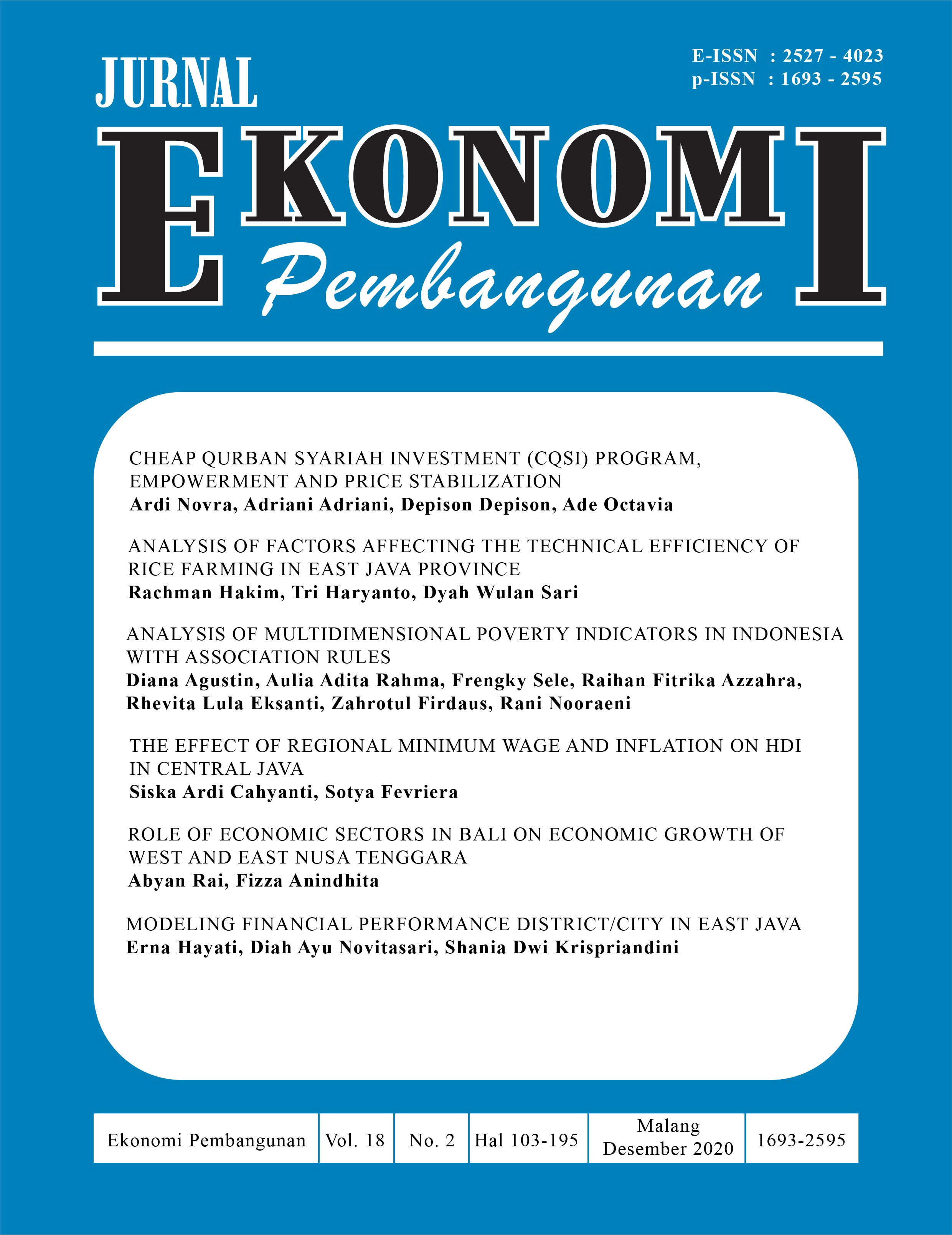Role Of Economic Sectors In Bali On Economic Growth Of West And East Nusa Tenggara
DOI:
https://doi.org/10.22219/jep.v18i2.14168Keywords:
Spillover effect, economic growth, VECMAbstract
Bali is a province that has significant economic strength in various sectors. Bali has proximity to the West Nusa Tenggara and East Nusa Tenggara Provinces, and financial interaction can occur. This study analyzes the spillover effect of the Balinese economy on West Nusa Tenggara and East Nusa Tenggara. It looks at the West Nusa Tenggara and East Nusa Tenggara economies' response when the Bali economic sector experiences a shock. The method used is VECM using quarterly real GRDP data of 35 observations. This study found a positive relationship between the service sector and the Bali industry in West Nusa Tenggara's economic growth. The Balinese industrial sector also has a positive relationship with East Nusa Tenggara's economic growth. The spillover effect did not occur between the Bali industrial sector in general and the development of West Nusa Tenggara and the Bali service sector in general and East Nusa Tenggara's economic growth. The Balinese economy, which has a spillover effect on West Nusa Tenggara and East Nusa Tenggara's economic growth in several sectors, can be used as a reference for the government to make economic development policies.
Downloads
References
Arika, Y. (2015). Pariwisata Bali WEST NUSA TENGGARA Tak Seharusnya “Nasib Tergantung Bali”. Retrieved 4 Oktober 2020, from https://travel.kompas.com/read/2015/04/29/143106627/Pariwisata.WEST NUSA TENGGARA.Tak.Seharusnya.Nasib.Tergantung.Bali.?page=all.
Barro, R. J. (1991). Economic Growth In A Cross Section of Countries. The Quarterly Journal of Economics, 106(2): 407-433.
Braniger, M. & Niebuhr, A. (2005). Agglomeration, Spatial Interaction, and Convergence in the E.U. Hamburg Institute of International Economy.
Enders, W. (2015). Applied Econometrics Time Series Fourth Edition. New York: John Wiley and Sons, Inc.
Ermalia, A.A.U. (2020). Bali Ekspor Komoditas Pertanian Senilai Rp2,65 Miliar Sehari. Retrieved 7 Oktober 2020, from https://bali.idntimes.com/business/economy/ayu-afria-ulita-ermalia/bali-ekspor-komoditas-pertanian-senilai-rp265-miliar-sehari/3.
Groenewold, N., Lee, G., & Chen, A. (2007). Regional Output Spillovers in China: Estimate from A VAR Model. Regional Science No.86, Vol. 1.
Gujarati, D.N., & Porter, D.C. (2008). Basic Econometrics Fifth Edition. New York: McGraw-Hill, Inc.
Jhingan, M.L. (2008). Ekonomi Pembangunan dan Perencanaan. Jakarta: Raja Grafindo Persada.
Jofre-Monseny, J., Lopez, R., & Marsal, E. (2012). What Underlies Localization and Urbanization Economies? Evidence from the Location of New Firms. IEB Working Papers.
Juanda, B., & Junaidi. (2012). Ekonometrika Deret Waktu Teori dan Aplikasi. Bogor: IPB Press.
Leburaya, L.A. (2009). Semoga Tenun EAST NUSA TENGGARA Rebut Pasar Global. Retrieved 3 Oktober 2020, from https://www.dekranasdaEast Nusa Tenggara.org/warta-dekranasda-East Nusa Tenggara/semoga-tenun-ikat-East Nusa Tenggara-rebut-pasar-global.html#:~:text=Tenun%20ikat%20asal%20Nusa%20Tenggara,pangsa%20pasar%20nasional%20dan%20global.&text=Menurut%20Ny%20Lucia%2C%20selama%20ini,kerajinan%20itu%20mendapat%20sambutan%20positif.
Mutiara, C.C., & Bendesa, I.K.G. (2016). Penyerapan Tenaga Kerja Sektoral Menurut Sifat Produksi Sektor Ekonomi Bali. E-jurnal Ekonomi Bisnis Universitas Udayana.
Myrdal, G. (1957). Economic Theory and Under-developed Regions. London: G. Duckworth.
Pasaribu, E., Priyarsono, D.S., Siregar, H., & Rustiadi, E. (2014). Dampak Spillover Effect Pusat-Pusat Pertumbuhan di Kalimantan. Jurnal Ekonomi dan Kebijakan Publik Vol.5(2).
Ridwan. (2016). Pembangunan Ekonomi Regional. Yogyakarta: Pustaka Puitika.
Sibero, A. (1985). Peningkatan Kemampuan Perencanaan dan Pelaksanaan Pembangunan Daerah. Prisma No.12.
Sumiati, M. (2015). Gerabah Lombok Diekspor Lewat Bali. Retrieved 4 Oktober 2020, from https://medanbisnisdaily.com/news/read/2015/10/23/193964/gerabah_lombok_diekspor_lewat_bali/.
Suparta, I. W. (2009). Spillover Effect Perekonomian Provinsi DKI Jakarta dan Sumatera Selatan Terhadap Pertumbuhan Ekonomi Provinsi Lampung. Jurnal Ekonomi Pembangunan Vol. 10(1).
Suranto, Y. (2011). Kayu Cendana Sebagai Bahan Baku Industri Kerajinan Rakyat Menyongsong Otonomi Daerah Propinsi Nusa Tenggara Timur. Berita Biologi Vol. 5(5).
Takahashi, K. (2009). Is South Sulawesi a Center of Growth in Eastern Indonesia: Japanese ODA Strategy Revisited. IDE Discussion Paper No. 186.2009.3.
Wei, W.S.S. (2006). Time Series Analysis Univariate and Multivariate Methods 2nd Edition. New York: Addison Wesley.
Downloads
Published
Issue
Section
License
Authors who publish with Jurnal Ekonomi Pembangunan (JEP) agree to the following terms:
- For all articles published in Jurnal Ekonomi Pembangunan (JEP), copyright is retained by the authors. Authors permit the publisher to announce the work with conditions. When the manuscript is accepted for publication, the authors agree to the publishing right's automatic transfer to the publisher.
- Authors retain copyright and grant the journal right of first publication with the work simultaneously licensed under a Creative Commons Attribution-NonCommercial-ShareAlike 4.0 International License that allows others to share the work with an acknowledgment of the work's authorship and initial publication in this journal.
- Authors can enter into separate, additional contractual arrangements for the non-exclusive distribution of the journal's published version of the work (e.g., post it to an institutional repository or publish it in a book), with an acknowledgment of its initial publication in this journal.
- Authors are permitted and encouraged to post their work online (e.g., in institutional repositories or on their website) before and during the submission process, as it can lead to productive exchanges and earlier and greater citation of published work (See The Effect of Open Access).

This work is licensed under a Creative Commons Attribution-NonCommercial-ShareAlike 4.0 International License.






















